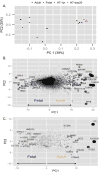Metabolic remodeling in early development and cardiomyocyte maturation
- PMID: 26912118
- PMCID: PMC4820352
- DOI: 10.1016/j.semcdb.2016.02.004
Metabolic remodeling in early development and cardiomyocyte maturation
Abstract
Aberrations in metabolism contribute to a large number of diseases, such as diabetes, obesity, cancer, and cardiovascular diseases, that have a substantial impact on the mortality rates and quality of life worldwide. However, the mechanisms leading to these changes in metabolic state--and whether they are conserved between diseases--is not well understood. Changes in metabolism similar to those seen in pathological conditions are observed during normal development in a number of different cell types. This provides hope that understanding the mechanism of these metabolic switches in normal development may provide useful insight in correcting them in pathological cases. Here, we focus on the metabolic remodeling observed both in early stage embryonic stem cells and during the maturation of cardiomyocytes.
Keywords: Cardiac maturation; Cardiomyocyte; Developmental transitions; Metabolism; Naïve to primed embryonic stem cell transition; Pluripotent stem cells; hESC.
Copyright © 2016 Elsevier Ltd. All rights reserved.
Figures


References
Publication types
MeSH terms
Grants and funding
LinkOut - more resources
Full Text Sources
Other Literature Sources

